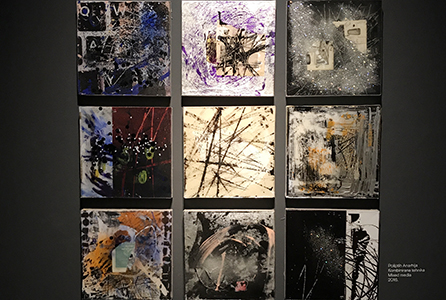Atlantic inspired to diversify
In an exclusive interview, Atlantic Tech Services has revealed that the work of a celebrated Croatian artist using its Azon print technology has inspired it to diversify into new markets.
Boris Guina, who has created his latest art exhibition ‘Reflexsion’ using dotted, circular, and irregular lines, merged together traditional printing techniques, with the digital inkjet technology of the Azonprinter Matrix.
Atlantic, which is the UK distributor for Azon, have taken note of the rise of using digital printers to create art and textiles, which can be further used to create fashion collections.

I’ve got to say, since our relationship with Azon, I’ve noticed there is a growing trend”
Keith Pratt, who leads the international business and development sector at Atlantic, comments: “As we are very active, not only in the commercial print market, through our insurance company Atlantic Print and in the sign and digital market with Atlantic Tech, you naturally get blinkered and focused on going to a traditional hardcore type of outlet. This is sign shops, people producing print, t-shirts etc, the quick print type shops.”
Pratt also notes that maybe a new market was presenting itself, and that artists and printers alike are becoming aware of the idea of using print.
He continues: “I just thought, ‘oh my goodness what if we are missing an opportunity?’ With the Azon, the flexibility of the range we’ve been looking at non-core business like the printing of tiles. Is there a market for us to go to tile producers and tile shops, where people might want unique old tiles put into their kitchen?
“I think that sort of trend is opening up lots of thoughts on none-core business. I think it’s very interesting. Ideally, we would like to talk to other artists—they’ve [Azon] developed this story with the Croatian artist, who has produced a lot of his images on textile and canvas.

The ‘Reflexsion’ exhibition showcases Guina’s work, where he has experimented with dots, spattering paint, irregular lines and scratching
“From an artist’s point of view, many artists haven’t even thought of this, and they produce their own works on different medias. They think, ‘can they get more revenue streams going, by expanding their operation?’ They’re opening their mind to be able to reproduce their works on different medias and sell them in bigger numbers.”
Pratt believes that artists turn to the Azon Matrix because it is of quality build, and the quality of the print. The Matrix is able to go up to 2,880dpi, which is a higher resolution compared to printers of a similar stature.
On the use of printers to create art and fashion, he finishes: “I’ve got to say, since our relationship with Azon, I’ve noticed there is a growing trend.”